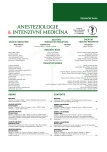Hypothermia in the operating theatre in paediatric patients: A prospective, monocentric, observational study
Authors:
A. Trčková 1; P. Košut 1; M. Klincová 1; H. Zelinková 2; T. Musilová 3; P. Štourač 1
Authors‘ workplace:
Klinika dětské anesteziologie a resuscitace, Fakultní nemocnice Brno, Lékařská fakulta, Masarykova univerzita
1; Institut biostatistiky a analýz, Lékařská fakulta, Masarykova univerzita
2; Lékařská fakulta, Masarykova univerzita
3
Published in:
Anest. intenziv. Med., 29, 2018, č. 6, s. 346-352
Category:
Overview
Objective:
Perioperative hypothermia is a common complication of general anaesthesia in children. The primary objective of the study was to detect the occurrence of hypothermia in a group of paediatric patients. The study enrolled paediatric patients aged 0-18 years of age indicated for surgery of estimated duration of more than 30 minutes. The secondary objective was to identify the risk factors for hypothermia.
Setting:
Department of Paediatric Anaesthesia and Intensive Care Medicine of University Hospital.
Materials and methods:
Prospective observational monocentric study conducted from the 1st April 2017 to 8th December 2017 at the Department of Paediatric Anaesthesiology and Intensive Care Medicine, University Hospital Brno. We observed the incidence of body temperature below 36.5 °C and below 36.0 °C
Results:
Temperature < 36.5 °C occurred in 66 % of patients, in the subgroup of patients under one year of age in 73 % and in the neonatal group in 87 %. 36 % of all patients experienced core body temperature under 36.0 °C. In the under one year subgroup it was captured in 41 % patients and in the neonatal subgroup we found temperature under 36.0 °C in 63 % of cases. We recorded a significantly higher incidence of body temperature below 36.5 °C in the subgroup of patiens with opening of a body cavity. We identified the operating theatre temperature as a statistically significant factor.
Conclusion:
The incidence of perioperative hypothermia under 36.0 °C in our paediatric patients was 36%. We identified the groups of patients at the highest risk of perioperative hypothermia: patients undergoing surgery involving body cavity opening and the low-age patient group.
keywords
body temperature – perioperative – children – paediatric anaesthesia – temperature management
Sources
1. Sessler DI. Complications and treatmentofmildhypothermia. Anesthesiology. 2001;95 : 531–543.
2. Dostálová V, Dostál P. Perioperační hypotermie u plánovaných terapeutických a diagnostických výkonů. Anesteziol Intenziv Medicína. 2015;26 : 8–16.
3. Sessler DI. Perioperative thermoregulation and heat balance. Lancet. 2016;387 : 2655–2664.
4. Horosz B, Malec-Milewska M. Inadvertent intraoperative hypothermia. Anaesthesiol Intensive Ther. 2013;45 : 38–43.
5. Perlman R, Callum J, Laflamme C, et al. A recommended early goal-directed management guideline for the preventiv of hypothermia-related transfusion, morbidity, and mortality in severely injured trauma patients. Crit Care LondEngl. 2016;20 : 107.
6. Billeter AT, Hohmann SF, Druen D, et al. Unintentional perioperative hypothermia is associated with severe complications and high mortality in electiveoperations. Surgery. 2014;156 : 1245–1252.
7. Hart SR, Bordes B, Hart J, et al. Unintended perioperative hypothermia. Ochsner J. 2011;11 : 259–270.
8. Adamus M, Cvachovec K, Černý V, et al. Zásady bezpečné anesteziologické péče. Anesteziol Intenziv Medicína. 2018;29 : 107–110.
9. Sessler DI. Temperature monitoring and perioperative thermoregulation. Anesthesiology. 2008;109 : 318–338.
10. Horosz B, Malec-Milewska M. Methods to prevent intraoperative hypothermia. Anaesthesiol Intensive Ther. 2014;46 : 96–100.
11. Witt L, Dennhardt N, Eich C, et al. Prevention of intraoperative hypothermia in neonates and infants: resultsof a prospective multicenter observational study with a newforced-air warming systém with in creased warm air flow. Pediatr Anesth. 2013;23 : 469–474.
12. von Elm E, Altman DG, Egger M, et al. The Strengtheningthe Reporting of Observational Studies in Epidemiology (STROBE) Statement: guidelinesfor reporting observational studies. Int J Surg Lond Engl. 2014;12 : 1495–1499.
13. Mixa V, Kaplanová V. Tělesná teplota dítěte v průběhu anestezie. Anesteziologie a intenzivní medicína – proLékaře.cz. Anest Intenziv Med [Internet]. [cited 2016 Dec 20];27. Availablefrom: http://www.prolekare.cz/anesteziologie-intenzivni-medicina-clanek/telesna-teplota-ditete-v-prubehu-anestezie-59658.
14. Kim P, Taghon T, Fetzer M, Tobias JD. Perioperative hypothermia in the pediatric population: a quality improvement project. Am J Med Qual Off J Am Coll Med Qual. 2013;28 : 400–406.
15. Tander B, Baris S, Karakaya D, et al. Risk factors influencing inadverten thypothermia in infants and neonates during anesthesia. PaediatrAnaesth. 2005;15 : 574–579.
16. Taguchi A, Ratnaraj J, Kabon B, et al. Effectsof a circulating-watergarment and forced-air warming on body heatcontent and core temperature. Anesthesiology. 2004;100 : 1058–1064.
17. Obare Pyszková L, Nevtípilová M, Žáčková D, et al. Výskyt hypotermie v perioperačním období – unicentrická observační studie. Anesteziol Intenziv Medicína. 2014;25 : 267–273.
18. Lenhardt R. Monitoring and thermal management. Best Pract Res Clin Anaesthesiol. 200;17 : 569–581.
19. Teran CG, Torrez-Llanos J, Teran-Miranda TE, et al. Clinical accuracy of a non-contact infrared skin thermometer in paediatric practice. Child: Care, Health and Development [Internet]. 2012[cited 2018 Sep 23];38 : 471–476. Available from: http://onlinelibrary.wiley.com/doi/abs/10.1111/j.1365-2214.2011.01264.x
Labels
Anaesthesiology, Resuscitation and Inten Intensive Care MedicineArticle was published in
Anaesthesiology and Intensive Care Medicine

2018 Issue 6
Most read in this issue
- ERAS in a Czech hospital – Utopia or Reality?
- Specifics of anaesthesia and intensive care in organ transplant patients
- Emergency medicine ultrasound curriculum for emergency medicine physicians
- Administration of 500 ml of normal saline does not result in immediate damage to the endothelial glycocalyx determinable by sublingual microcirculation assessment
